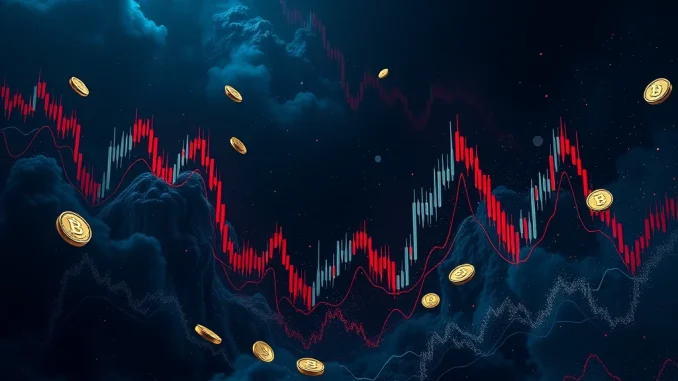
The world of cryptocurrency trading is known for its rapid, often dramatic swings. While volatility is a constant companion, certain events underscore the inherent risks involved, especially when leverage is used. One such event unfolded recently, sending ripples through the market: a stunning crypto futures liquidation wave that saw hundreds of millions of dollars vanish in a mere sixty minutes.
What Just Happened? Understanding Crypto Futures Liquidation
In the past hour alone, major cryptocurrency exchanges witnessed approximately $371 million worth of futures positions being liquidated. This follows a larger trend over the past 24 hours, where total liquidations across the market reached around $558 million. While $558 million over a full day is significant, the concentration of $371 million within just one hour is particularly noteworthy and highlights a sudden, sharp price movement that caught many leveraged traders off guard.
So, what exactly does a “liquidation” mean in the context of cryptocurrency futures?
- Futures Contracts: These are agreements to buy or sell an asset (like Bitcoin or Ethereum) at a predetermined price at a specific time in the future. They allow traders to speculate on price movements without owning the underlying asset.
- Leverage: Traders often use leverage in futures trading, meaning they borrow funds to open positions much larger than their initial capital (margin). Leverage can amplify profits, but it also dramatically increases risk.
- Margin Call & Liquidation: If the market moves against a leveraged position, the trader’s margin might fall below the minimum required level to keep the position open. The exchange will first issue a margin call (requesting more funds). If the trader cannot or does not add more funds quickly, the exchange automatically closes the position at the current market price to prevent further losses – this is a liquidation. The trader loses their initial margin and potentially more, depending on the market move and leverage used.
Why Does Such a Large Leverage Trading Crypto Event Occur?
Massive liquidation events like the one just seen are typically triggered by sharp, sudden price movements in the underlying assets (most commonly Bitcoin and Ethereum, which constitute the bulk of open interest in futures markets). When prices move rapidly in one direction, a large number of leveraged positions betting on the opposite direction quickly become unprofitable and hit their liquidation price points simultaneously.
Consider a trader using 50x leverage on a Bitcoin long position (betting the price will go up). If Bitcoin’s price drops by just 2%, their position could be liquidated, wiping out their entire margin. When a cascade of such liquidations happens, it can even exacerbate the price move, as the forced selling from liquidated long positions (or forced buying from liquidated short positions) adds further pressure to the market direction.
Navigating Crypto Market Volatility: Risks and Rewards
The recent $371 million liquidation surge is a stark reminder of the extreme crypto market volatility. While volatility presents opportunities for significant gains, especially with leverage, it also carries substantial risks. For traders using high leverage, a small adverse price movement can lead to total loss of capital very quickly.
Key Risks of Leverage Trading:
- Amplified Losses: Just as leverage amplifies gains, it equally amplifies losses.
- Liquidation Risk: The primary risk. Your entire margin can be wiped out if the market moves against you.
- Stress and Emotional Decisions: High leverage can lead to intense psychological pressure, potentially resulting in poor trading decisions.
- Funding Rates: Holding leveraged positions often involves paying or receiving funding fees, which can eat into profits or increase costs.
While the potential for amplified returns makes leverage trading crypto appealing to some, events like massive liquidations highlight that it is suitable only for experienced traders with a deep understanding of market dynamics and robust risk management strategies.
Futures Trading Explained: Beyond the Headlines
Beyond the dramatic headlines of liquidations, futures trading explained simply is a sophisticated tool used by both speculators and hedgers in traditional and crypto markets. It allows for price discovery, provides liquidity, and enables complex trading strategies. However, the accessibility of high leverage on crypto exchanges distinguishes it significantly from traditional futures markets and is the primary driver behind the large liquidation numbers we frequently see.
For those considering futures trading, it’s crucial to:
- Start Small: Use minimal or no leverage initially to understand how it works.
- Use Stop-Loss Orders: These automatically close your position if the price reaches a certain point, limiting potential losses.
- Understand Margin Requirements: Know how much price movement your position can withstand before facing liquidation.
- Manage Risk: Never risk more capital than you can afford to lose on a single trade or in total.
Conclusion: A Cautionary Tale from the Futures Market
The rapid liquidation of $371 million in crypto futures within a single hour serves as a powerful illustration of the inherent risks associated with high-leverage trading in a volatile market. While cryptocurrency futures offer opportunities for significant gains, they demand a high level of expertise, discipline, and stringent risk management. For participants in this dynamic market, understanding the mechanics of liquidation and respecting the power of crypto market volatility is paramount to navigating these turbulent waters successfully.
Whether you are engaging in leverage trading crypto or simply observing the market, these events underscore the importance of caution and informed decision-making. The goal isn’t just to chase potential profits but to preserve capital in the face of unpredictable market swings. As the market continues to evolve, so too must traders’ understanding and approach to managing risk in the complex world of futures trading explained.



